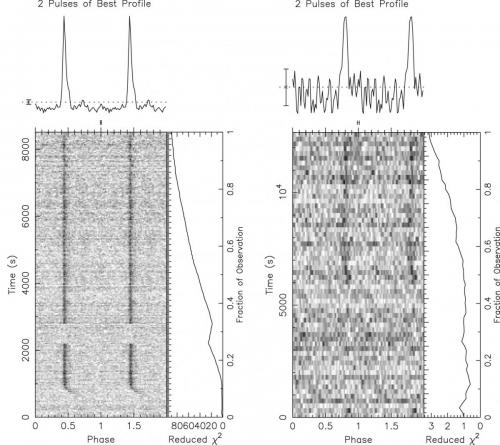Pulsar Discovery from an Enormous Telescope
Magnetized neutron stars in distant globular clusters are a challenge to detect — but it’s a job made easier by the world’s largest filled-aperture radio telescope. Recent high-sensitivity observations have uncovered an erratic new star system.

The 500-m FAST radio dish, built into a natural basin in southwest China.
Pulses from Distant Clusters
Pulsars are the compact remnants of dead stars that shine powerful beams of emission into space as they spin. The brightness of these beams and the regular timing of their pulsations makes pulsars valuable targets for observatories; not only can they tell us about stellar evolution and their environments, but they also serve as probes of the interstellar medium, space-time, and more.

Artist’s illustration of a pulsar (left) and its small stellar companion (right), viewed within their orbital plane.
Since the discovery of the first pulsar in 1967, we’ve found thousands of these stellar clocks in our galaxy. While many are located relatively nearby in the galactic disk, we’ve also observed a population of pulsars in the distant globular clusters that orbit the Milky Way. These pulsars are a useful tool for probing a very different environment: the dense stellar cores made up of an old population of stars.

Hubble image of the globular cluster M92.
Until recently, we’d only discovered 156 pulsars in 29 globular clusters; due to these clusters’ large distances (tens to hundreds of thousands of light-years away), it takes very powerful and sensitive radio telescopes to find them using deep surveys. Now, a new observatory has entered the game.

Comparison of the FAST (bottom) and Arecibo Observatory (top)
radio dish profiles at the same scale.
A Powerful Telescope
The Five-hundred-meter Aperture Spherical radio Telescope (FAST), built into the hilly landscape in southwest China, is the world’s largest filled-aperture telescope. Its size dwarfs that of the Arecibo Observatory in Puerto Rico, and its dish has the advantage of being shapable — the panels that make up its surface can be tilted by a computer to change the telescope’s focus.

Phase-folded pulse data for PSR J1717+408A, as observed by FAST (left panel) and by the Green Bank Telescope (right panel). Eclipses are visible as breaks in the data. The difference in sensitivity between the two telescopes is starkly evident.
FAST achieved first light in 2016, and it’s been going undergoing testing and commissioning for the last few years. As of January 2020, the FAST is officially open for business, and we’re now seeing some of the major results coming from this powerful radio observatory.
Among them: the first discovery of an eclipsing binary pulsar in globular cluster M92, as reported in a recent publication led by Zichen Pan (NAO, Chinese Academy of Sciences).
An Exotic System
Pan and collaborators announce the FAST detection of a pulsar with a pulse period of 3.16 milliseconds orbiting around a low-mass companion in a globular cluster that’s about 27,000 light-years away.
This pulsar, PSR J1717+408A, is in a close (period of 0.20 days) eclipsing orbit with its companion, making it what’s known as a “red-back pulsar”. Radiation from the pulsar has pummeled its companion star, creating a cloud of ionized material that surrounds it and causes the pulsar’s eclipses to vary in duration and timing.
The discovery of this object demonstrates the potential of FAST as a probe of the globular cluster pulsar population. More observations of M92 are planned in the future, as well as observations of dozens of even richer clusters. Keep an eye out for more FAST results as this telescope ramps up operations!
Source: American Astronomical Society
- 365 reads
Human Rights
Fostering a More Humane World: The 28th Eurasian Economic Summi

Conscience, Hope, and Action: Keys to Global Peace and Sustainability

Ringing FOWPAL’s Peace Bell for the World:Nobel Peace Prize Laureates’ Visions and Actions

Protecting the World’s Cultural Diversity for a Sustainable Future

Puppet Show I International Friendship Day 2020

